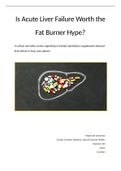Is Acute Liver Failure Worth the
Fat Burner Hype?
A critical narrative review regarding to herbal and dietary supplement-induced
liver failure in four case reports.
Maastricht University |
Faculty of Health, Medicine, and Life Sciences (FHML) |
Bachelor GW |
Name |
I-number |
, E-mail |
Abstract
Herbal and dietary supplements (HDS) are being bought more than ever and are advertised to
increase weight loss via a stimulation of lipolysis or by inhibition of lipogenesis. Patients assume that
these supplements are free from harmful effects because they are ‘natural’. However, the aftermath
of so called “fat burners” are being underestimated in which some of the ingredients can cause drug-
induced liver injury (DILI), such as hepatotoxicity. The listing of HDS that claims body weight
reduction is far-reaching. The substances considered as HDS associated with liver injury in this review
are Chinese skullcap, green tea extracts, gum gummel extracts, hydroxycitric acid, spirulina, turmeric,
and usnic acid. This literature review summarizes the current evidence of hepatotoxic ingredients
from HDS of published case reports from 2011 to 2021 and outlines gaps in current knowledge.
Keywords: DILI; fat burners; HDS; hepatotoxicity; liver failure
Introduction
The worldwide prevalence of obese and overweight people has increased threefold the past 30
years. A recent study from the European Journal of Public Health shows that more than half of the
European population is overweight and obese. 1 Due to limited motivation and/or time for exercise
many individuals are struggling to find an effective way to lose weight. To eventually reach this
weight reduction, people will search for a quick and effortless availability of supplements which
causes a massive growth in unconventional methods of weight reduction, such as the use of herbal
and dietary supplements (HDS).
Because of the easy availability of herbal and dietary supplements the prevalence of supplement use
has increased drastically within years. The use of HDS has gained popularity among adults also
because consumers expect that these products are ‘natural’, and they assume they are safe to use.
Concluded from The Journal of Nutrition the dietary supplement use in 1994 consisted of 35% for
males and 43% among females while the estimated use of HDS in 2006 contained about 44% for
males and 53% for females, an approximately 10% increase over twelve years In the United States. 2
Particularly, HDS are being associated with hepatotoxic reactions, thus because of the increased HDS
sales, also the HDS hepatotoxicity reports will increase over time (Fig. 1). Due to this increase in HDS
use, 20% of all hepatotoxic cases in the United States are HDL-induced liver injury, thus the focus
point in this review.3
, Fig. 1: correlation between HDS sales and HDS hepatotoxicity reports.
Even though the efficacy of supplements remains unknown, HDS owes its increased popularity to all
the promising advertisements that are offered, such as: “burn belly fat”, and “boost metabolism”.
Jeukendrup et al. are claiming that nutrition supplements, often referred as ‘fat burners’, acutely
increase fat metabolism or energy expenditure, impair fat absorption, increase weight loss, and
increase fat oxidation during exercise (Fig.2).4 The gained increased fat metabolism after taking HDS’s
is according to Lee et al. and Bloomer et al. explicable by the acute increase of lipolysis in plasma,
thus releasing fatty acids from fat stored in adipose tissue. 5-6




